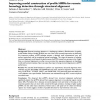122 search results - page 21 / 25 » Protein Fold Recognition using Residue-Based Alignments of S... |
BMCBI
2007
13 years 7 months ago
2007
Background: Remote homology detection is a challenging problem in Bioinformatics. Arguably, profile Hidden Markov Models (pHMMs) are one of the most successful approaches in addre...
CIBCB
2005
IEEE
14 years 1 months ago
2005
IEEE
- Establishing structure-function relationships on the proteomic scale is a unique challenge faced by bioinformatics and molecular biosciences. Large protein families represent nat...
BMCBI
2004
13 years 7 months ago
2004
Background: In a previous paper, we introduced MUSCLE, a new program for creating multiple alignments of protein sequences, giving a brief summary of the algorithm and showing MUS...
BMCBI
2008
13 years 7 months ago
2008
Background: A multiple sequence alignment (MSA) generated for a protein can be used to characterise residues by means of a statistical analysis of single columns. In addition to t...
BMCBI
2007
13 years 7 months ago
2007
Background: By virtue of their shared ancestry, homologous sequences are similar in their structure and function. Consequently, multiple sequence alignments are routinely used to ...

